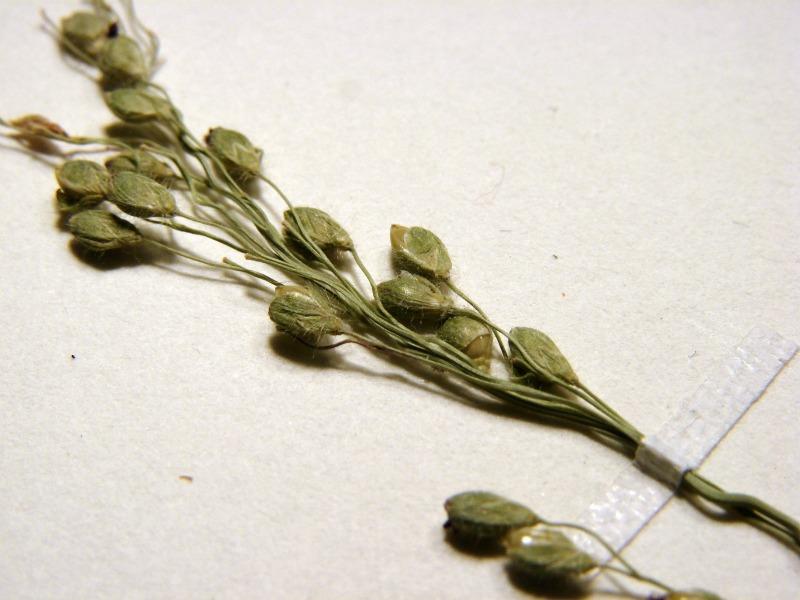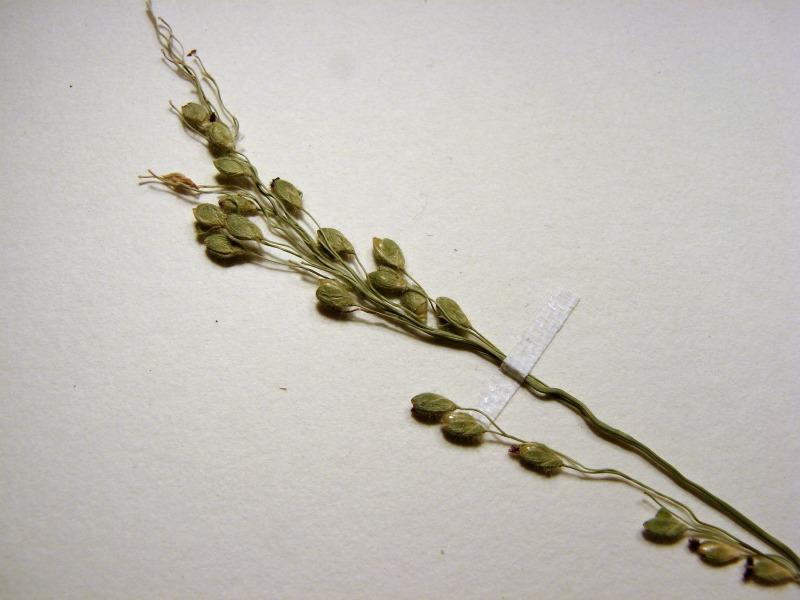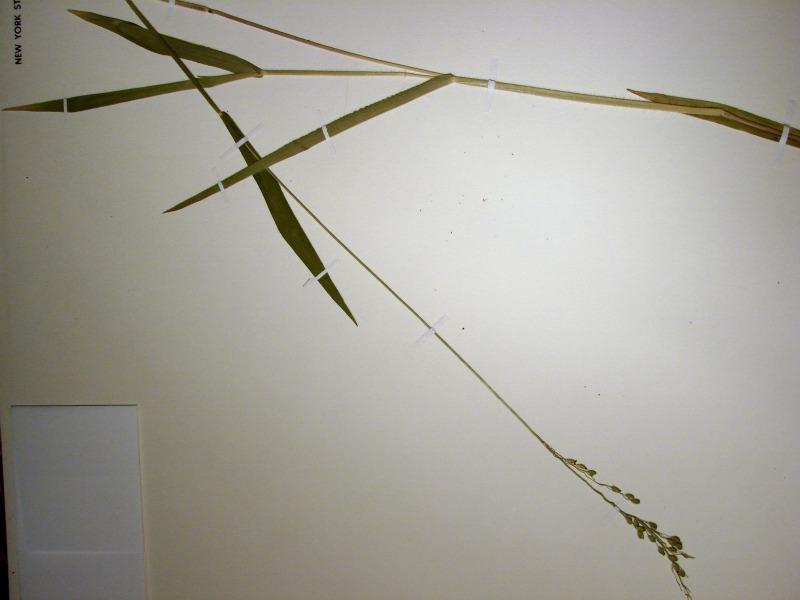Leiberg's Rosette Grass
Dichanthelium leibergii (Vasey) Freckmann
- Class
- Monocotyledoneae (Monocots)
- Family
- Poaceae (Grass Family)
- State Protection
- Endangered
Listed as Endangered by New York State: in imminent danger of extirpation in New York. For animals, taking, importation, transportation, or possession is prohibited, except under license or permit. For plants, removal or damage without the consent of the landowner is prohibited.
- Federal Protection
- Not Listed
- State Conservation Status Rank
- S1
Critically Imperiled in New York - Especially vulnerable to disappearing from New York due to extreme rarity or other factors; typically 5 or fewer populations or locations in New York, very few individuals, very restricted range, very few remaining acres (or miles of stream), and/or very steep declines.
- Global Conservation Status Rank
- G4
Apparently Secure globally - Uncommon in the world but not rare; usually widespread, but may be rare in some parts of its range; possibly some cause for long-term concern due to declines or other factors.
Summary
Did you know?
This prairie grass was first collected in New York in 1832 at the head of Seneca Lake. That was the only collection ever known from the state until 1992 when it was found in a small grassland at Oakwood Cemetery in Troy. The species is named in honor of John B. Leiberg who made many plant collections in the Midwest and Northwest for the US government and the Smithsonian in the late 1800s and early 1900s. His wife Carrie was a doctor who traveled to her patients by railway handcar (Parker 2010).
State Ranking Justification
There is one existing occurrence but it is rather small. There is one historical occurrence from the 1830s that is probably extirpated.
Short-term Trends
The single population seems to be stable.
Long-term Trends
The species was only ever known from one locality in the state through the last 170 years. It is not expected that many more populations will be found.
Conservation and Management
Threats
The plants are in a natural grass area of a cemetery and they are mowed periodically. Improper mowing or maintenance could threaten these plants in the future but presently the threat is low.
Conservation Strategies and Management Practices
Continue the present mowing schedule to preserve the open grassy area where these plants grow.
Research Needs
Research could be done into why the plants prefer their present locality and determine if they are likely to spread or are growing in similar settings in the area.
Habitat
Habitat
The only extant population known in New York is in a dry opening in a woods in a cemetary. There is also a historical record from Schuyler County, at a site described only as a wet meadow (New York Natural Heritage Program 2007). Dry to wet prairies and prairie-like places (Voss 1972). Prairies, meadows and open woods (Fernald 1970). Dry prairies and open places (Gleason & Cronquist 1991).
Associated Ecological Communities
- Sedge meadow*
(guide)
A wet meadow community that has organic soils (muck or fibrous peat). Soils are permanently saturated and seasonally flooded. The dominant herbs must be members of the sedge family, typically of the genus Carex.
* probable association but not confirmed.
Range
New York State Distribution
In New York this species known only from a single collection each in Schuyler and Rennsalaer Counties.
Global Distribution
New York is the at the eastern range of this species, which is found west through Ontario to as far as Alberta in the North, and in the upper midwestern states to as far west as Kansas in the south.
Identification Comments
General Description
This species is a perennial grass which grows from 24 to 80 cm tall and forms large tufts. There are 3 or 4 stem leaves. The panicle is at first hidden within the the stem sheath but eventually becomes exserted, and is 6-10 cm long and half as wide. The 20-40 spikelets are 3.7-4mm long, and covered with 0.5-1+ mm long hairs.
Best Life Stage for Proper Identification
Material with mature fruit is necessary for identification. Dicanthelium species may flower twice; identification guides and keys are typically based on the the first, early summer infloresences.
Similar Species
Dichanthelium xanthophysum and D. oligosanthes have spikelets that are glabrous or only minutely hairy, the hairs all well under 0.5 mm.
Best Time to See
Fruits develop June to early September.
- Fruiting
The time of year you would expect to find Leiberg's Rosette Grass fruiting in New York.
Leiberg's Rosette Grass Images
Taxonomy
Leiberg's Rosette Grass
Dichanthelium leibergii (Vasey) Freckmann
- Kingdom Plantae
- Phylum Anthophyta
- Class Monocotyledoneae
(Monocots)
- Order Cyperales
- Family Poaceae (Grass Family)
- Order Cyperales
- Class Monocotyledoneae
(Monocots)
- Phylum Anthophyta
Additional Common Names
- Leiberg's Panic Grass
- Panic Grass
Synonyms
- Panicum leibergii (Vasey) Scribn.
Additional Resources
Best Identification Reference
Flora of North America Editorial Committee. 2003. Flora of North America, North of Mexico. Volume 25. Magnoliophyta: Commelinidae (in part): Poaceae, part 2. Oxford University Press, New York. 783 pp.
Other References
Fernald, M.L. 1950. Gray's manual of botany. 8th edition. D. Van Nostrand, New York. 1632 pp.
Gleason, Henry A. and A. Cronquist. 1991. Manual of Vascular Plants of Northeastern United States and Adjacent Canada. The New York Botanical Garden, Bronx, New York. 910 pp.
Hitchcock, A.S. 1951. Manual of the grasses of the United States. 2nd edition revised by Agnes Chase. [Reprinted, 1971, in 2 vols., by Dover Publications, Incorporated, New York.]
Holmgren, Noel. 1998. The Illustrated Companion to Gleason and Cronquist's Manual. Illustrations of the Vascular Plants of Northeastern United States and Adjacent Canada. The New York Botanical Garden, Bronx, New York.
Mosley, Bob. 1999. Reflections on John Leiberg's Contribution to Plant Conservation in Idaho. Sage Notes, Newsletter of the Idaho Native Plant Society. Vol 21(4). Fall 1999.
New York Natural Heritage Program. 2010. Biotics database. New York Natural Heritage Program. New York State Department of Environmental Conservation. Albany, NY.
New York Natural Heritage Program. 2024. New York Natural Heritage Program Databases. Albany, NY.
Rhoads, Ann F. and Timothy A. Block. 2000. The Plants of Pennsylvania, an Illustrated Manual. University of Pennsylvania Press, Philadelphia, PA.
Voss, E.G. 1972. Michigan Flora, Part I. Gymnosperms and Monocots. Cranbrook Institute of Science Bulletin 55 and the University of Michigan Herbarium. Ann Arbor. 488 pp.
Weldy, T. and D. Werier. 2010. New York flora atlas. [S.M. Landry, K.N. Campbell, and L.D. Mabe (original application development), Florida Center for Community Design and Research http://www.fccdr.usf.edu/. University of South Florida http://www.usf.edu/]. New York Flora Association http://newyork.plantatlas.usf.edu/, Albany, New York
Weldy, Troy W. and David Werier. 2005. New York Flora Atlas. [S.M. Landry, K.N. Campbell, and L.D. Mabe (original application development), Florida Center for Community Design and Research. University of South Florida]. New York Flora Association, Albany, NY. Available on the web at (http://newyork.plantatlas.usf.edu/).
Links
About This Guide
Information for this guide was last updated on: January 18, 2008
Please cite this page as:
New York Natural Heritage Program. 2024.
Online Conservation Guide for
Dichanthelium leibergii.
Available from: https://guides.nynhp.org/leibergs-panic-grass/.
Accessed July 26, 2024.


